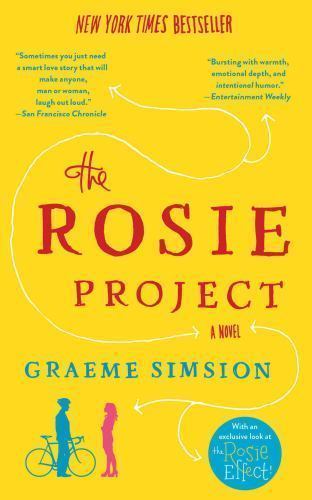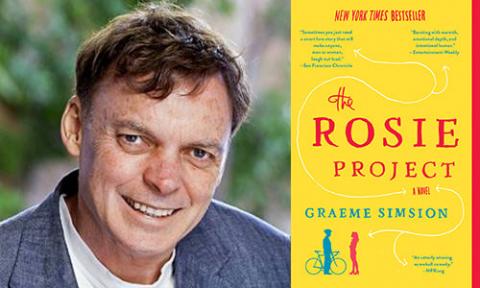 Written by: Graeme Simsion
Written by: Graeme Simsion
Simon & Schuster paperback edition, 2013
292 pages
Genre: Buddy Love… with a touch of Fool Triumphant
How does The Rosie Project hit Blake Snyder’s story beats? Here is the Save the Cat!® beat sheet for the novel:
Australian novelist Graeme Simsion created one of my favorite novels of the decade. From the moment I picked up The Rosie Project, I was hooked. It was positively brimming with humor and heart, the narrative voice was engaging, and the structure was simply beautiful. It was the kind of story I found myself recommending to everyone: friends, family members, a number of local book clubs, countless readers online, random people who talked to me in grocery store checkout lines…
I’ve read it from cover to cover several times now, most recently this spring when I studied it from a beat sheet perspective. To me, it was a textbook example of stellar plotting. And given that the author originally wrote the story as a movie treatment before expanding it into a novel, I’m certain Simsion was familiar with screenwriting structure. (I wouldn’t be at all surprised if he was a Save the Cat! fan, too.) In transitioning this story to book form, he didn’t lose a beat. Literally.
For anyone not familiar with this New York Times bestselling novel, here is the back cover blurb:
Don Tillman, genetics professor, is getting married. Or he will be, when his sixteen-page, scientifically valid survey yields a candidate (see: the Wife Project). Designed to filter out the drinkers, the smokers, the vegans, the late arrivers, Don’s questionnaire is, for this socially challenged academic, the most logical method to find the perfect partner.
Enter Rosie Jarman.
Don quickly disqualifies her as a potential wife but is drawn into Rosie’s quest to find her biological father (see: the Father Project). When something like a friendship develops, Don must confront the spontaneous whirlwind that is Rosie and the decidedly unscientific conclusion that sometimes you don’t find love, it finds you.
If you haven’t yet had a chance to pick up this entertaining novel, I hope you’ll give it a read. It’s also been optioned by Sony Pictures and may be in pre-production. The film has had several big names attached to it to star and direct but there have been a lot of changes and, as of this writing, there’s no set release date. I’d love to see it on the big screen soon, though… fingers crossed!
And now, the Beats!
Opening Image (page 1): Highly intelligent Australian genetics professor Don Tillman, who is on the Asperger’s/autism spectrum but doesn’t realize it, believes he’s found a solution to the “Wife Problem,” which involves him finding an ideal mate despite his quirky personality.
Theme Stated (pages 12-15): Two comments from two different women are used in tandem to highlight the theme. Julie—the lady running the Asperger’s lecture that Don is giving to the young “Aspies”—says to him about the children, “If they don’t change, they’re not going to have real relationships; they’ll never have partners.” However, Daphne, an older lady Don had befriended before she passed away, once said to him that he would “make a wonderful husband” and that “there’s someone for everyone.” Don admits this is “statistically correct.”
Set-Up (pages 1-38): Tremendous order and organization in Don’s life. Readers are given the minute-to-minute rundown of his day. Don takes his routine very seriously.
Catalyst (pages 39-47): He meets Rosie, a psychology PhD student, when she appears at his office door. After she tells Don that his friend Gene sent her to him, Don is convinced that Rosie is there because she’s a compatible romantic match for him. Don had created an extensive dating questionnaire (which he shared with Gene, and his friend said he’d “help” him with the “Wife Project”), so Don is sure this is the reason for Rosie’s appearance. But this is an incorrect assumption. That isn’t at all why Gene told Rosie to visit him.
Debate (pages 48-68): Don is very attracted to Rosie, despite her obvious unsuitability—at least according to his questionnaire. She has dyed hair and dresses in a sloppy manner, she smokes, and she’s frequently late. He cannot imagine what his friend Gene was thinking. However, Don wonders if he should date Rosie anyway. After all, experiments require a control group and, thus far, the questionnaire hadn’t worked to find him a perfect match. Also, Rosie has a problem—she is trying to identify her biological father—and Don, who is a persistent puzzle solver, thinks he might be able to help her.
Break into Two (pages 68-71): Don decides to visit Rosie at the bar where she works and spend the time with her during the hours he would have otherwise allocated for his Wife Project, at least until a more suitable romantic candidate emerges for him.
B Story (pages 72-98): Instinct displaces logic when Don is with Rosie. She is desperately trying to figure out the name of her biological father, and Don has some ideas of how to find the answer. He works to get DNA samples of two men who are Rosie’s potential fathers and, even though the results are negative, he and Rosie spend some time together, which turns out to be surprisingly pleasant for him.
Fun and Games (pages 99-130): Various Rosie and Don outings follow as the two of them come up with strategies for finding other potential fathers and collecting DNA samples from them, most memorably, making complicated cocktails for a room full of doctors. At one point, Rosie asks Don to pretend to be her boyfriend. As a result of these activities, they both get to know each other better and find they have a lot of fun in each other’s company. Don starts to feel “at the brink of another world” when he’s with her. He changes his schedule repeatedly to accommodate her and to try to solve the mystery of her paternity.
Midpoint (pages 131-150): False defeat. The Dean at the university wants him to try harder to “fit in,” and Don’s search for a wife (even though it’s been on the backburner while he’s been working with Rosie) gives him a reason to attempt it. He finally finds somebody whose answers fit what he’s looking for on the dating questionnaire, and it’s a woman who loves to dance. Don takes it upon himself to learn—with the help of a skeleton in his office. He invites this woman to a staff dance, and Rosie is there with a date.
She’s furious with Don because she’s just discovered that he thought her initial reason for meeting him was because she wanted to be a candidate for his Wife Project. She’s even angrier with Gene for not correcting that impression. Nevertheless, she still comes to Don’s rescue when his date with the dancer turns disastrous, and it’s clear to the reader—if not to Don—that she has real feelings for him. On the way home after the event, Rosie and Don share a taxi. She casually suggests sex, which he declines on account of their supposed “incompatibility”… although, later, he regrets refusing her.
Bad Guys Close In (pages 151-239): Don is unable to simply return to his old way of life and the routine that always comforted him. He tries to tamp down his feelings of anger—both at Rosie and at himself. With the money he receives as an inheritance from his late friend Daphne, Don takes Rosie on a trip to New York City. He doesn’t like to leave anything unfinished, and this is a way to complete her “Father Project” and obtain the last remaining samples of DNA needed to determine her paternity. They collect samples, meet new people, and explore Columbia University.
During the course of this overseas excursion, the suggestion of sex comes up again and Don appears to be eager to go along with it this time. However, he spends so long preparing to return to Rosie’s room that she changes her mind. Don eventually realizes he delayed because he was afraid of the deep emotional involvement. The Father Project officially comes to an end.
All Is Lost (pages 239-240): Don is depressed. Rosie thinks that he’s too attached to his schedule, that he messes up socially too often and, worst of all, that he can’t feel love. He fears she may be right.
Dark Night of the Soul (pages 241-242): In a conversation with Gene, Don decides that he can prove to Rosie that he most definitely can feel love, as well as show her that he can break out of his old routine.
Break into Three (pages 243-248): Don sets out to fix the situation with Rosie. He starts by watching her favorite romantic films and taking notes, determining there are consistent principles of behavior in a romantic relationship.
Finale (pages 248-285): Don puts a less restrictive schedule into practice: only class lectures and appointments, not absolutely everything. He also revamps his wardrobe and appearance to be more socially acceptable. He’s determined to make Rosie fall in love with him. He systematically eliminates a number of “unconventional mannerisms” from his vocabulary, while juggling his work duties and even managing to get funding for his Australian university, thanks to a genetics project he created as a “cover” when trying to get DNA samples for Rosie. He also meets the man Rosie considers her stepfather and boxes with him at the gym.
Don learns valuable information about Rosie this way—and also about himself. He discovers he doesn’t have to be visibly “odd” anymore. That in the past, he often chose to emphasize his differences as a defense mechanism. But he has many skills others don’t and some of these are quite advantageous. He might be able to find another woman to “partner” with (even without the use of a questionnaire) but, most importantly, he realizes that despite his unconventional personality, he possesses an undeniable degree of empathy… at least with real people, if not fictional ones. He loves Rosie and has finally learned how to open up and trust her.
Final Image (pages 286-292): Don, now married and living in the United States with Rosie, has figured out who her biological father is but, above all, he’s discovered that he’s grateful for the illogical assumptions that led to him meeting Rosie and to their falling in love.
Marilyn Brant
5 Comments
Leave a Reply Cancel reply
You must be logged in to post a comment.










Dear Ms. Brant,
Thank you for a well-written beat sheet for a book that’s new to me. I then visited Amazon, and read the first several pages of the book. Amusing and droll.
One of my nephews, 23, is also on the (I believe it’s called) “autism spectrum.” Reading only those first few pages, I nonetheless immediately recognized my nephew’s unique responses to everyday life.
Thanks again for the example of “Save The Cat’s” increasingly familiar use of Beats.
Cheers, Rodrick
Hi Rodrick,
Many thanks for your kind words. I’m thrilled that you liked the beat sheet and that it led you to reading some of The Rosie Project! I’ll admit, the author’s narration through Don’s POV was especially fascinating for me — I enjoyed seeing the world through his eyes. Loved the insight and the humor, too.
Have a wonderful weekend!
? Marilyn
That “?” was supposed to be a smiley face, lol. Phones…
:-)
Hi Marilyn, I enjoyed your beat sheets. I read The Rosie Project sometime in the last year, and you nailed the book. :)
Edie, thank you!!!
Knowing your writing and your wonderful sense of humor, I’m not surprised you were drawn to reading The Rosie Project :) .
And thanks for commenting. I’m so glad you thought my beat sheet fit the story! xox ~M.